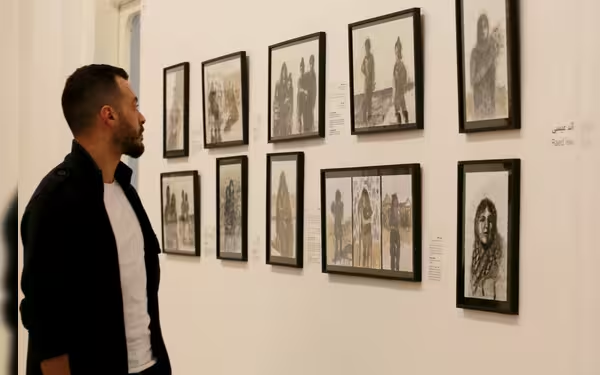Sunday, November 17, 2024 12:23 AM
Palestinian Artists Share Gaza's Trauma Through Smuggled Art
- Artworks reveal the trauma and resilience of Gaza's people.
- Artists smuggled pieces to highlight their suffering.
- Exhibition showcases 79 poignant artworks from Gaza.
 Image Credits: arabnewspk
Image Credits: arabnewspkPalestinian artists smuggle their art from Gaza, revealing trauma and resilience amid ongoing conflict in a poignant exhibition in Amman.
In the midst of ongoing conflict, art often serves as a powerful medium for expression and communication. This is particularly true for Palestinian artists who, in the wake of the devastating war in Gaza, have found themselves in a desperate situation. With their homeland under siege, these artists have resorted to smuggling their works out of the war-torn territory to share their stories with the world. The exhibition titled "Under Fire" in Amman, Jordan, showcases these poignant pieces, revealing the trauma and resilience of the people of Gaza.
For six months, artists in Gaza handed over their paintings and other artworks to individuals leaving through the Rafah border crossing with Egypt. This was their only means of sharing their experiences and emotions as the conflict escalated. The situation became dire when Israeli ground forces closed the border in May, effectively trapping the artists within the narrow coastal strip. According to reports, more than 43,500 people, mostly civilians, have lost their lives due to the ongoing military campaign, leading to a humanitarian disaster.
Mohammad Shaqdih, the deputy director of Darat Al-Funun, the gallery hosting the exhibition, emphasized the significance of these artworks. He stated, "The paintings document the brutality of war and massacres... carrying pain and sorrow, but also embodying an unwavering resolve." The four artists behind these creations—Basel Al-Maqousi, Raed Issa, Majed Shala, and Suhail Salem—remain trapped in Gaza, unable to escape the horrors surrounding them.
The exhibition features 79 artworks made from improvised materials, such as medicine wrappers, and natural pigments derived from hibiscus, pomegranate, and tea. These pieces vividly depict the harsh realities of life in Gaza, showcasing scenes of destruction, displacement, and despair. One artwork portrays families fleeing on donkey-drawn carts, while another captures the haunting expressions of emaciated children clinging to their mothers. Suhail Salem poignantly noted, "I can’t paint with colors and expensive pigments because there are more pressing priorities here in Gaza, like food, drink and finding safety for myself and my family."
In a heartfelt letter displayed alongside his work, Majed Shala shared his personal experience of displacement. He described how he lost his home, studio, and 30 years of artwork to the conflict. Initially paralyzed by the chaos, he eventually began to document the real-life scenes of suffering that have become a part of daily life for many in Gaza. His reflections resonate deeply, as he connects the current situation to the historical trauma of the 1948 Nakba, or "catastrophe," when hundreds of thousands of Palestinians were displaced during the creation of Israel.
Visitors to the exhibition, such as engineer Victoria Dabdoub, expressed their emotional responses to the artwork. She remarked, "It is important that works like these are shared worldwide so that people can feel the pain, sorrow, and suffering of the people of Gaza." This sentiment underscores the vital role of art in bridging cultural divides and fostering empathy.
As the world watches the ongoing crisis in Gaza, the stories told through these artworks serve as a reminder of the human cost of conflict. They invite us to reflect on the resilience of the human spirit in the face of unimaginable adversity. In sharing their pain and experiences, these artists not only preserve their narratives but also challenge us to acknowledge the suffering of others. Art, in its many forms, remains a powerful tool for connection and understanding, urging us to listen and respond to the cries of those in need.













